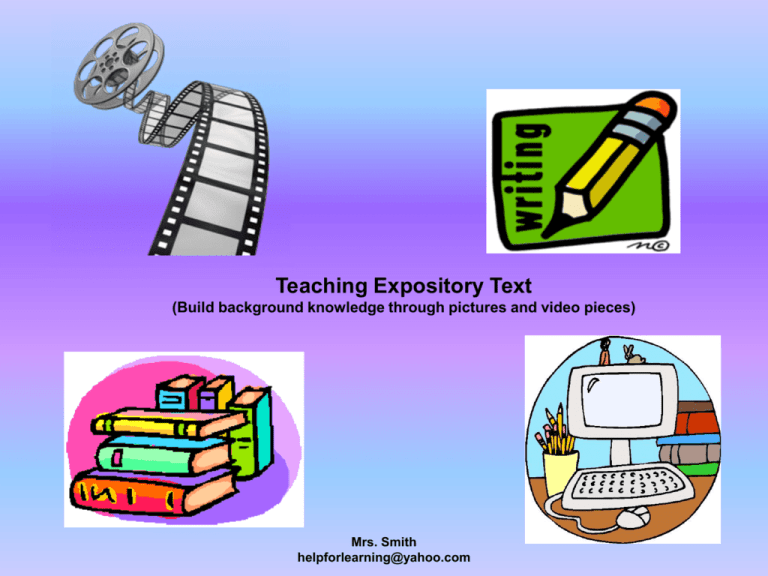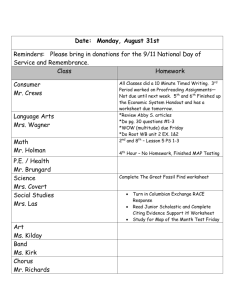TeachingExpositoryTe..
advertisement

Teaching Expository Text (Build background knowledge through pictures and video pieces) Mrs. Smith helpforlearning@yahoo.com Teaching Expository Text Essential Questions: How do good writers choose to present information? How do I know I am clear about what I just read? How do the authors' text pattern choices impact the message? Possible presentation structure: 1.Begin the unit with a discussion of definitions using Text Structure Lesson Handout. Explain that signal/cue words can help to determine a pattern. Direct attention to the organizers for each pattern. Have students note that they may have seen some of the “frames” while reading Science and Social Studies texts. (included text pieces here may be used for jigsaw presentations) 2. Student Jigsaw-Each student group teaches their pattern to the class. 3. Beyond Practice-additional practice with photos, video clips and text pieces 4. Text structure quiz practice pieces are found on Quia.com 5. Test on Quia.com 6. Video-Hoodwinked-structure practice with a media format (review sheet with students before showing) 7. Ancestry Brochure-Summative Assessment-writing component Directions for Jigsaw: Students Jig Saw” the five different text patterns and present to the class. (This was the favorite activity of the year.) Begin by dividing students into five groups, one for each structure. Each person within the group has an assigned task to complete for their group. Internet and YouTube are needed to access videos and practice pieces. Allow approximately two-four days for students to research and organize their materials and another five days for presentations. Groups presentations are to include one instructional piece, with a completed text organizer for that piece, a matching video clip and a practice piece (to be completed the next day) from the resources listed on the Jigsaw Resource chart. Students will need to notify teacher which practice text piece they would like to use to allow teacher copy time. Follow presentation order on Jigsaw Group Planning Sheet. Activities on Beyond Chart may be used for additional class practice or as part of regular instruction. Run text copies for students if you used this. For these pieces: view photo, discuss, then view video sample if there is one, read instructional piece. Students complete Formative Skill worksheet. If time, compare/contrast video to text piece. Materials Needed: Project Organizer, Chart paper for students to create their organizer, LCD projector, internet access, youtube access, various worksheets (summative, formative) resource chart, DVD-Hoodwinked. Hoodwinked Activity Additional worksheet practice can be found on http://www.ereadingworksheets.com/ Mrs. Smith helpforlearning@yahoo.com Included Unit Resources • • • • • • • • • • • • • • Ancestry Project Directions Ancestry Project Template Angel/Ellis Island Alternate Organizer-Student Angel/Ellis Island Alternate Organizer-Teacher Alternate Angel/Ellis Island Compare/Contrast Organizer “Choices” Quotes for Bell Work (word sheet and power point format) Formative Skill Worksheet Hoodwinked Worksheet Jigsaw Activity Organizer Planning Calendar Resource Lists for Video Clips and Text pieces Summative Skill Worksheet Text Structure Lesson Worksheet Quiz practice and Quiz links on Quia.com Mrs. Smith helpforlearning@yahoo.com Possible Common Core Standards Addressed CC.7.R.I.5 Craft and Structure: Analyze the structure an author uses to organize a text, including how the major sections contribute to the whole and to the development of the ideas. CC.7.R.I.7 Integration of Knowledge and Ideas: Compare and contrast a text to an audio, video, or multimedia version of the text, analyzing each medium’s portrayal of the subject (e.g. how the delivery of a speech affects the impact of the words). CC.7.R.I.10 Range of Reading and Level of Text Complexity: By the end of the year, read and comprehend literary nonfiction in the grades 6–8 text complexity band proficiently, with scaffolding as needed at the high end of the range. CC.7.W.4 Production and Distribution of Writing: Produce clear and coherent writing in which the development, organization, and style are appropriate to task, purpose, and audience. Mrs. Smith helpforlearning@yahoo.com



